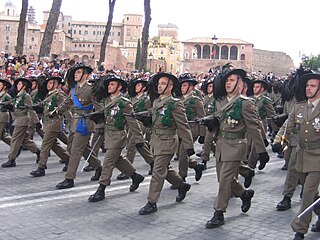
The Bersaglieri, singular Bersagliere, are a troop of marksmen in the Italian Army's infantry corps. They were originally created by General Alessandro Ferrero La Marmora on 18 June 1836 to serve in the Royal Sardinian Army, which later became the Royal Italian Army. They can be recognized by their distinctive wide-brimmed hats decorated with black western capercaillie feathers, which is worn with the dress uniform. The feathers are also applied to their combat helmets.
The Gold Medal of Military Valour is an Italian medal established on 21 May 1793 by King Victor Amadeus III of Sardinia for deeds of outstanding gallantry in war by junior officers and soldiers.
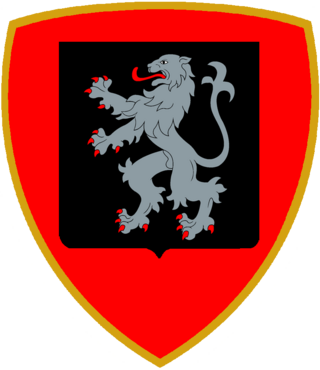
The Mechanized Brigade "Aosta" is a mechanized infantry brigade of the Italian Army based on the island of Sicily. The Brigade is one of the oldest of the Italian Army and the name connects the brigade to its original area of recruitment the Aosta Valley and therefore the brigade's coat of arms is modeled after the coat of arms of Aosta. The brigade is part of the Division "Acqui".

Giovanni Romero was an Italian colonel who participated in several conflicts during the 19th century. He participated in the Second Italian War of Independence and the Third Italian War of Independence, most notably leading the 4th Africa Infantry Regiment during the Battle of Adwa of the First Italo-Ethiopian War before being killed at the battle. Romero was also a posthumous recipient of the Gold Medal of Military Valour.

Raffaele Aversa was an Italian soldier and Resistance member, most notable for having carried out the arrest of Benito Mussolini after his dismissal as Prime Minister of Italy on 25 July 1943.
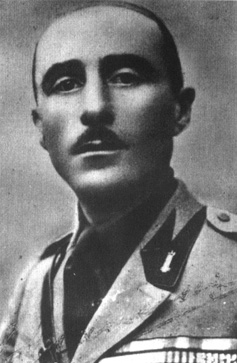
Enrico Francisci was an Italian Blackshirt general during World War II.
Augusto Ugolini was an officer in the Royal Italian Army during World War II, best known for his leadership during the battle of Culqualber, for which he was awarded the Gold Medal of Military Valor.
Azzo Passalacqua was an Italian general during World War II.

Luigi Nava was an Italian General of the Army who participated in the First Italo-Ethiopian War and World War I. He participated in the Italian colonial campaign in the Horn of Africa which lead to his participation at the Battle of Adwa, where he was wounded and taken prisoner by the Abyssinians. Having become Lieutenant General, at the action of the general mobilization of 1915 he was appointed commander of the 4th Army but was dismissed from the command four months after Italy entered the war.
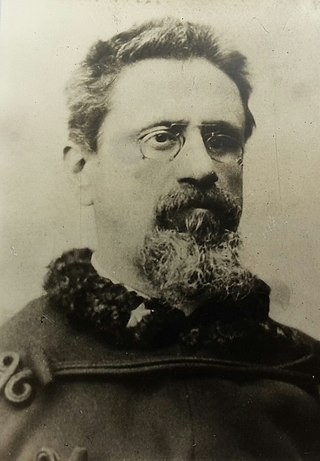
Cesare Airaghi was an Italian colonel and war hero who participated in several conflicts during the 19th-century. Airaghi participated at the Second Italian War of Independence, the Third Italian War of Independence and the First Italo-Ethiopian War before being killed at the Battle of Adwa.
Amedeo De Cia was an Italian general during World War II.
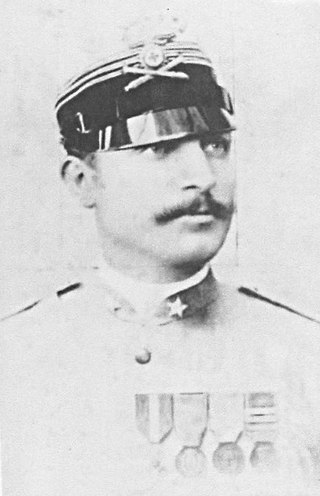
Edoardo Bianchini was an Italian captain of the First Italo-Ethiopian War. He commanded the 3rd Mountain Artillery Battery during the Battle of Adwa before being killed at the battle. He was also a posthumous recipient of the Gold Medal of Military Valor for his service at the battle.

Umberto Masotto was an Italian Captain who served in the First Italo-Ethiopian War. He commanded the 4th Mountain Artillery Battery during the Battle of Adwa but was more famously known for being the first field gunner to receive the Gold Medal of Military Valour.

Trentino La Barba was an Italian soldier and Resistance fighter during World War II.

Francesco De Rosa was an Italian major of the First Italo-Ethiopian War. He commanded the 1st Artillery Brigade during the Battle of Adwa and was a posthumous recipient of the Gold Medal of Military Valor for his brave service in the battle before being killed in action.
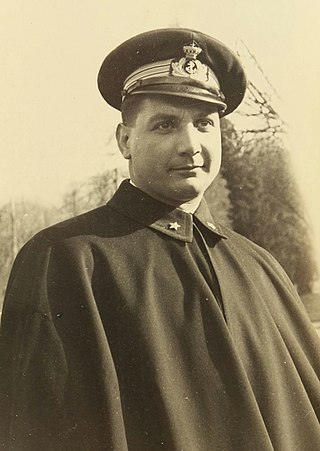
Alfeo Brandimarte was an Italian naval officer and Resistance member during World War II.
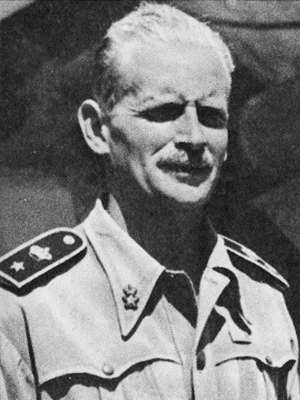
Giuseppe Cigala Fulgosi was an Italian naval officer during World War II.

Giuseppe Antonio Baudoin was an Italian major of the Third Italian War of Independence and the First Italo-Ethiopian War. He commanded the 9th Africa Infantry Battalion during the Battle of Adwa before being killed in the battle. He was a posthumous recipient of the Gold Medal of Military Valor for his service in the battle.

Antonino Di Giorgio was an Italian general and politician, who fought in the First Italo-Ethiopian War, the Italo-Turkish War and the First World War, and served as Minister of War of the Kingdom of Italy from April 1924 to April 1925. He resigned after the rejection of his plan for a radical reform of the Royal Italian Army.
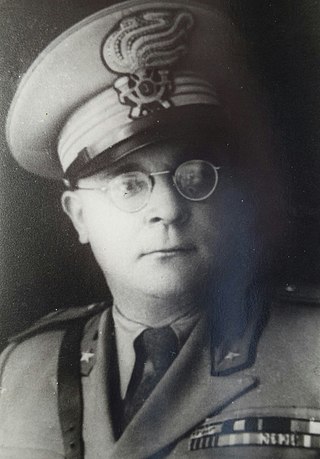
Aminto Caretto was an Italian Arditi and Bersaglieri officer, commander of the XXVI Arditi unit in World War I and of the 3rd Bersaglieri Regiment in World War II. He was mortally wounded on the Eastern Front during World War II and posthumously awarded the Gold Medal of Military Valor.
















